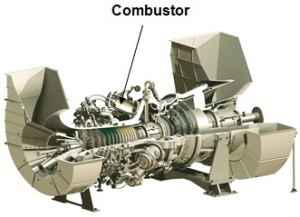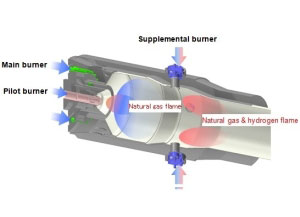Kawasaki to Launch 30 MW-class High-efficiency Gas Turbine L30A Featuring New Low-NOx Hydrogen Combustion Technology
Feb. 20, 2014

for testing high-temperature, high-pressure combustion
Tokyo, February 20, 2014 — Kawasaki Heavy Industries, Ltd. announced today that it has developed a new NOx reduction technology for the dry low emissions (DLE) combustor integrated into gas turbines.
With a world-first technology for gas turbine using 60% per volume hydrogen content gas, the NOx emissions level of the DLE combustor, which features Kawasaki's proprietary supplemental firing combustion system*1, will be kept to 25 ppm or less at 15% O2 — a level that is on par with natural gas-fired turbines. Kawasaki is set to move forward with efforts to market its 30 MW-class high-efficiency gas turbine L30A featuring this technology, with plans to put it on the market during FY2015.
While NOx is generated during the gas turbine fuel combustion process, the amount produced largely depends on the combustion temperature. DLE combustors employ a premixed combustion method where fuel is premixed with air to minimize combustion temperature without the use of injected water or steam. Although this significantly reduces NOx emissions at low cost, fuel concentration needs to be controlled in order to maintain stable combustion. However, the difference in flame speed has made this a challenge, especially when burning hydrogen gas, which would often burn close to the burner and result in flashback.
Kawasaki has already developed and commercialized DLE combustors featuring a multistage burner process employing a pilot burner as well as main and supplemental burners. The new development builds on the proven technology of the DLE combustor and uses the pilot and main burners for natural gas, while enhancing the supplemental burners, which pose minimal risk of flashback, for burning hydrogen gas. This enhancement has enabled a mixed combustion of hydrogen gas amounting to 60% per volume of fuel (30% in quantity of heat). The low-NOx performance of the new technology has been verified using the facility of Japan Aerospace Exploration Agency for testing high-temperature, high-pressure combustion.
Gas turbines employing mixed combustion of hydrogen gas can reduce the amount of natural gas usage as well as CO2 emissions by making effective use of unused hydrogen gas, produced as by-products in oil refineries and petrochemical plants. With this technology, hydrogen gas can be used at any rate from 0 to 60% (0 to 30% in quantity of heat) per volume, allowing usage to be adjusted flexibly according to the amount of by-product gas produced. While needs for the effective use of by-product gas continue to grow, NOx emissions regulations are expected to become even more stringent in the future. To respond to these trends, Kawasaki is working to take its NOx reduction technology even further with its DLE combustors.
As part of its ongoing efforts to protect the environment, Kawasaki is working to enhance overall gas turbine efficiency and develop innovative hydrogen technologies that will lower gas turbine emissions.
- *1
- A system that can maintain combustion even under conditions that are not conducive to sustained combustion by injecting air and fuel from the supplemental burners, in addition to the combustion gas blown in through the pilot and main burners.
- *2
- A system that reduces NOx emissions by minimizing combustion temperature without the use of injected water or steam.
Structural diagram


Contact
If you need more information about our business,
don’t hesitate to contact us.





